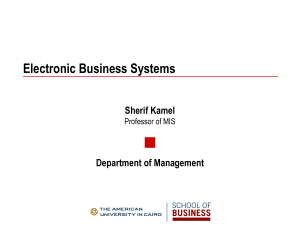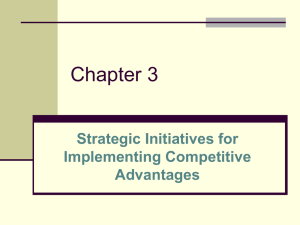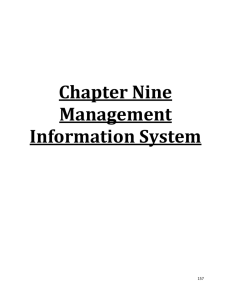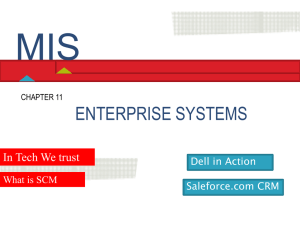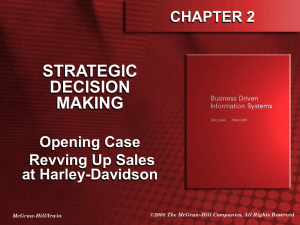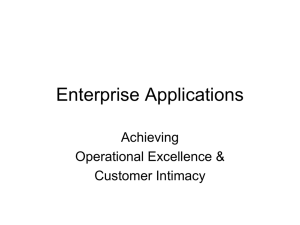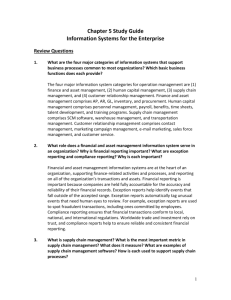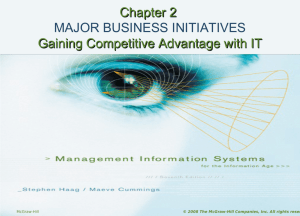chapter_03
advertisement
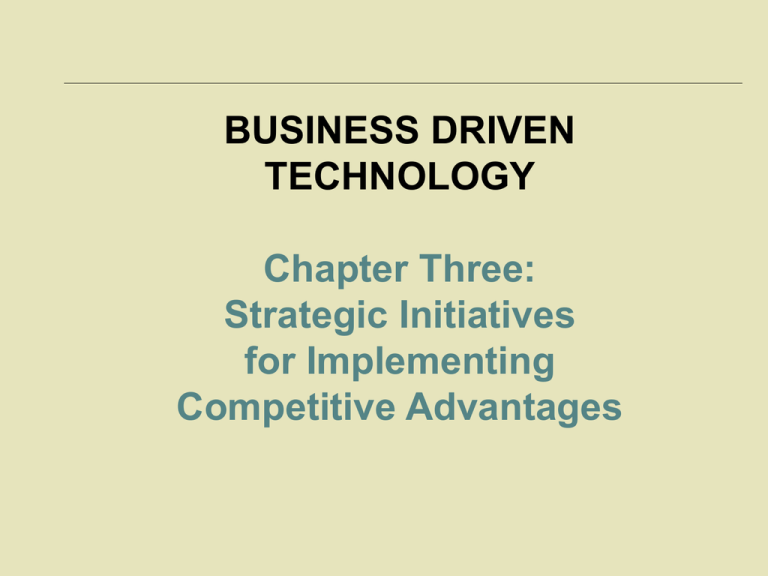
BUSINESS DRIVEN TECHNOLOGY Chapter Three: Strategic Initiatives for Implementing Competitive Advantages LEARNING OUTCOMES 3.1 List and describe the four basic components of supply chain management 3.2 Explain customer relationship management systems and how they can help organizations understand their customers 3.3 Summarize the importance of enterprise resource planning systems 2/24 OPENING CASE Trek: a leader in bicycle products and accessories • 30% worldwide market by streamlining operations • Through the implementation of several IT systems • Ability to obtain key management information to drive business decision in line with business goals • Their 1,400 dealers enter orders, check availability, view account receivable and credit summaries via the web. Order increase 20 – 30 % per week 3/24 CHAPTER THREE OVERVIEW • Introduces three high-profile strategic initiatives: – Supply chain management (SCM) – Customer relationship management (CRM) – Enterprise resource planning (ERP) 4/24 SUPPLY CHAIN MANAGEMENT • Supply Chain Management (SCM)– involves the management of information flows between and among stages in a supply chain to maximize total supply chain effectiveness and profitability 5/24 SUPPLY CHAIN MANAGEMENT • Four basic components of supply chain management include: – Supply chain strategy – strategy for managing all resources to meet customer demand – Supply chain partners – partners throughout the supply chain that deliver finished products, raw materials, and services. – Supply chain operation – schedule for production activities, testing, packaging, preparation for delivery – Supply chain logistics – product delivery process 6/24 Wal-Mart & Procter-Gamble • Tremendous successful SCM system • Link Wal-Mart’s distribution centers directly to P&G ’s manufacturing centers • Every purchase, the system sends a message directly to factory to restock the product and alert when the product is running low • This on line system allows P&G to efficiently make and deliver products without having to maintain large stock, generate invoices and receives payment automatically • So P&G can offer a discount price to Wal-Mart 7/24 SUPPLY CHAIN MANAGEMENT • Wal-Mart and Procter & Gamble (P&G) SCM 8/24 SUPPLY CHAIN MANAGEMENT • Effective and efficient SCM systems can enable an organization to: – Decrease the power of its buyers – Increase its own supplier power – Increase switching costs to reduce the threat of substitute products or services – Create entry barriers thereby reducing the threat of new entrants – Increase efficiencies while seeking a competitive advantage through cost leadership 9/24 SUPPLY CHAIN MANAGEMENT • Effective and efficient SCM systems effect on Porter’s Five Forces 10/24 CUSTOMER RELATIONSHIP MANAGEMENT • Customer relationship management (CRM) – involves managing all aspects of a customer’s relationship with an organization to increase customer loyalty and retention and an organization's profitability • Many organizations, such as Charles Schwab (brokers) and Kaiser Permanente (84,000 diabetic patients), have obtained great success through the implementation of CRM systems 11/24 Charles Schwab • Gain return on investment of their CRM in less than two years. • Developed by Siebel, allows brokerage firm to trace each interaction with a customer or prospective customer • Provide services e.g. retirement planning • Can classify: serious investors and non-serious one to allocate time and resources to serious one 12/24 CUSTOMER RELATIONSHIP MANAGEMENT • CRM is not just technology, but a strategy, process, and business goal that an organization must embrace on an enterprisewide level • CRM can enable an organization to: – Increase customer loyalty & retention, spending – Identify types of customers – Design individual customer marketing campaigns – Treat each customer as an individual – Understand customer buying and shopping behaviors – Increase sales and greater profitability 13/24 CUSTOMER RELATIONSHIP MANAGEMENT • CRM overview 14/24 ENTERPRISE RESOURCE PLANNING • Enterprise resource planning (ERP) – integrates all departments and functions throughout an organization into a single IT system so that employees can make enterprisewide decisions by viewing enterprisewide information on all business operations • Keyword in ERP is “enterprise” 15/24 ENTERPRISE RESOURCE PLANNING • Organizations typically operate by functional areas or functional silos or independent areas » Each functional area has it own systems and communicates with every other functional area. • In fact functional areas are interdependent: e.g. sales must rely on information from operation to understand inventory and be able to place orders, calculate transportation costs, and gain insight into product availability based on production schedules 16/24 Functional Silos: undertakes a specific core function • Sales & Marketing: demand forecasting, sales forecasting, market segmentation, advertising, campaigns and promotions, bids and quotes, order processing, order management, customer relationship management, and customer support • Operation & Logistic: purchasing, supplying, receiving, transportation, production, shipping, manufacturing and maintenance, production planning, material management, order entry and order processing, warehouse management, transportation management, and customer service management • Accounting & Finance: financial and cost accounting, planning, budgeting, cash flow, tax compliance, general ledger, accounts payable, treasury management, and cost control • Human Resource: hiring, training, benefits, and payroll 17/24 ENTERPRISE RESOURCE PLANNING • ERP’s goal – every department or functional area work together sharing common information and not be a “silo” • This requires that all IT systems – including hardware, software, information and people – be integrated with one another. • The organization must maintain a consistent IT infrastructure – hardware, software, and telecommunications equipment that, when combined, provide the underlying foundation to support the organization's goal – The problem with maintaining a consistent IT infrastructure occurs when a single department decides to implement a new system without taking into consideration the other departments or overall organizational 18/24 ENTERPRISE RESOURCE PLANNING • Organizations use many integration tools to integrate IT infrastructures including: – Intranets – an internalized portion of the Internet, protected from outside access, that allows an organization to provide access to information and application software to only its employees » Intranets support information and application software sharing across different IT infrastructures – Enterprise information portals (EIPs) – an Internet site owned and operated by an organization to support its operations. » EIPs often operate within an intranet and work in a fashion similar to popular Internet search tools such as Google. 19/24 ENTERPRISE RESOURCE PLANNING 20/24 ENTERPRISE RESOURCE PLANNING • Large ERP vendors include – SAP: One of the first vendors to develop a comprehensive ERP system / Market Dominant – PeopleSoft – Oracle • Most ERP solutions include SCM and CRM components 21/24 OPENING CASE STUDY QUESTIONS How Levi’s Got Its Jeans into Wal-Mart 1. Which of Porter’s Five Forces did Levi’s address through the implementation of its updated supply chain management system? 2. Evaluate how Levi’s can gain business intelligence through the implementation of a customer relationship management system 3. Create an argument against the following statement: “Levi’s should not invest any resources to upgrade its current supply chain management system” 22/24 CHAPTER THREE CASE Consolidating Touchpoints for Saab • Saab required a consolidated customer view among its three primary channels (touch points): • Dealer network (220 dealers) • Customer assistance center • Lead management center Each one has different database which causes a number of problems e.g. redundant contact, ineffective pitch • Saab’s challenge is to complete with rivals who attract customer through aggressive marketing campaign, reduced prices, and inexpensive financing. • Using Siebel Automotive, Saab received the following benefits: • • • • Direct marketing costs decreased by 5 % Lead follow-up increased from 38% to 50% Customer satisfaction increased from 69% to 75% Gained a single view of its customers across multiple channels 23/24 CHAPTER THREE CASE QUESTIONS 1. Explain how implementing a CRM system enabled Saab to gain a competitive advantage 2. Estimate the potential impact to Saab’s business if it had not implemented a CRM system 3. What additional benefits could Saab receive from implementing a supply chain management system? 24/24
